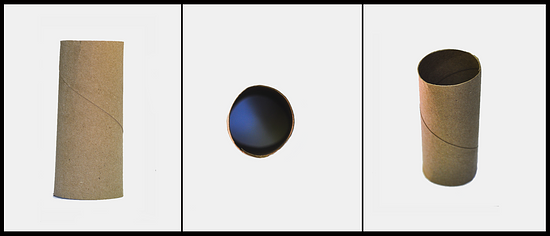Lesson 3Exploring Circumference
Let’s explore the circumference of circles.
Learning Targets:
- I can describe the relationship between circumference and diameter of any circle.
- I can explain what means.
3.1 Which Is Greater?
Clare wonders if the height of the toilet paper tube or the distance around the tube is greater. What information would she need in order to solve the problem? How could she find this out?

3.2 Measuring Circumference and Diameter
Coins, cookies, and drinking glasses are some examples of common circular objects.
-
Explore the applet to find the diameter and the circumference of three circular objects to the nearest tenth of a unit. Record your measurements in the table.
-
Plot the diameter and circumference values from the table on the coordinate plane. What do you notice?
- Plot the points from two other groups on the same coordinate plane. Do you see the same pattern that you noticed earlier?
Are you ready for more?
Suppose you had another circular object with a diameter that is half as long as the diameter of your largest circle. What would its circumference be?
3.3 Calculating Circumference and Diameter
Here are five circles. One measurement for each circle is given in the table.

Use the constant of proportionality estimated in the previous activity to complete the table.
| diameter (cm) | circumference (cm) | |
|---|---|---|
| circle A | 3 | |
| circle B | 10 | |
| circle C | 24 | |
| circle D | 18 | |
| circle E | 1 |
Are you ready for more?
The circumference of the Earth is approximately 40,000 km. If you made a circle of wire around the globe, that is only 10 meters (0.01 km) longer than the circumference of the globe, could a flea, a mouse, or even a person creep under it?
Lesson 3 Summary
There is a proportional relationship between the diameter and circumference of any circle. That means that if we write for circumference and for diameter, we know that , where is the constant of proportionality.
The exact value for the constant of proportionality is called . Some frequently used approximations for are , 3.14, and 3.14159, but none of these is exactly .

We can use this to estimate the circumference if we know the diameter, and vice versa. For example, using 3.1 as an approximation for , if a circle has a diameter of 4 cm, then the circumference is about or 12.4 cm.
The relationship between the circumference and the diameter can be written as
Glossary Terms
There is a proportional relationship between the diameter and circumference of any circle. The constant of proportionality is pi. The symbol for pi is .
We can represent this relationship with the equation , where represents the circumference and represents the diameter.
Some approximations for are , 3.14, and 3.14159.

Lesson 3 Practice Problems
Diego measured the diameter and circumference of several circular objects and recorded his measurements in the table.
object diameter (cm) circumference (cm) half dollar coin 3 10 flying disc 23 28 jar lid 8 25 flower pot 15 48 One of his measurements is inaccurate. Which measurement is it? Explain how you know.
Complete the table. Use one of the approximate values for discussed in class (for example 3.14, , 3.1416). Explain or show your reasoning.
object diameter circumference hula hoop 35 in circular pond 556 ft magnifying glass 5.2 cm car tire 71.6 in - Name a segment that is a radius. How long is it?
- Name a segment that is a diameter. How long is it?

- Consider the equation . Find four pairs of and values that make the equation true. Plot the points on the coordinate plane.
- Based on the graph, can this be a proportional relationship? Why or why not?

The graph shows the relationship between the number of cups of flour and the number of cups of sugar in Lin’s favorite brownie recipe.
The table shows the amounts of flour and sugar needed for Noah’s favorite brownie recipe.
amount of sugar (cups) amount of flour (cups) 1 3 2 3 - Noah and Lin buy a 12-cup bag of sugar and divide it evenly to make their recipes. If they each use all their sugar, how much flour do they each need?
- Noah and Lin buy a 10-cup bag of flour and divide it evenly to make their recipes. If they each use all their flour, how much sugar do they each need?